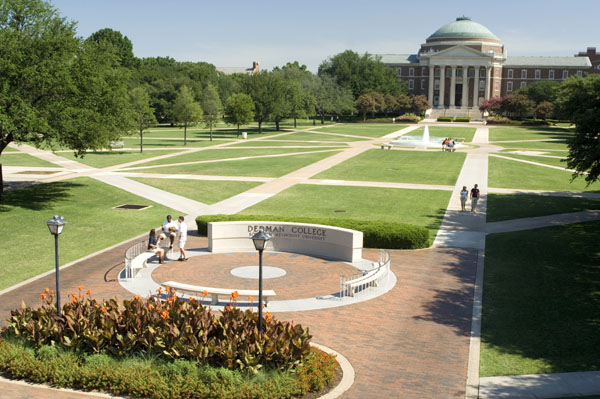Building a lawn worthy of the North Texas heat
SMU landscape expert Kevin Dilliard offers solutions for helping lawns survive the North Texas heat.
SMU Landscape Resource Manager Kevin Dilliard offers North Texas homeowners solutions for sprucing up their lawns —and dealing with the summer’s heat:
The Problem:
Dead zones – patches of grass that have yet to “green up.”
The Reality:
They’re not going to spring back to life without some intervention.
KEVIN’S DIY SOLUTIONS
- Out With the Old, in With the New – Maybe: For isolated, small patches, don’t immediately assume you have to run out and buy sod. Save yourself a little money by simply raking out the old grass, then keeping the soil moist. There’s a good chance the surrounding grass will make its way in.
- Clipping Service: If you have St. Augustine grass, which many of us do, save its “runners,” or root offshoots from lawn mower clippings, to use as a layer of mulch. Topping the raked soil with runners will keep it moist and help speed up the rooting of new grass.
- Investigate Irrigation Issues: Maybe a sprinkler head is broken and an area isn’t getting the water it needs. Or maybe your dead zone is on a slope, which means too much water is running off and not sinking in.
- Finally – Consider New Sod: If none of these techniques help, you can always buy plug-ins and re-sod. But first, decide the amount of sod you’ll need (prices vary), and consider the grass currently growing. Is it working for you or against you?
THE PROS AND CONS OF ST. AUGUSTINE
Pros: While not native to North Texas, St. Augustine does fine here if properly cared for. It offers emerald-green color and Deep South charm. It’s also the most affordable grass.
Cons: St. Augustine needs more water than most other grasses. In drought-prone Texas, that can be a liability due to municipal water restrictions. Because of its affordability, many developers use it to landscape properties, ultimately putting the burden of heavy maintenance (sometimes costly) on the property owners-to-be.
WHAT GRASSES ARE BEST SUITED FOR NORTH TEXAS?
| Lawn Gets … | Kevin’s Picks … |
| Mostly sun | “Common” Bermuda |
| Sun with some shade | “Celebration” Bermuda |
| Sun with mostly shade | Zoysia, such as “Zorro,” which SMU prefers |
| Mostly shade | Since all grass needs 4 to 6 hours of direct sunlight each day to thrive, opt instead for: Groundcover such as Asian jasmine, liriope (aka “monkey grass”), mondo grass (regular and dwarf) and mulch such as bark, pecan shell and pine straw. Note: Cedar mulch helps keep bugs away while pine bark mulch is good for acid-loving plants such as hydrangeas, azaleas and magnolias. |
WATER BASICS
- Bermuda and zoysia grasses need half as much water as St. Augustine, but can cost 50 to 100 percent more than St. Augustine. The upfront costs, however, will save money in the long run and help preserve water.
- Adhere to your area’s water restrictions or face a fine. Those in Dallas and Richardson (starting June 1) can water twice a week while those in University Park have time-of-day restrictions. Go online to your municipality’s website to learn more.
- Watering too little or too much accounts for 90 percent of all grass problems, Kevin says. Either your soil is too compact, your site too sloped to allow absorption (leading to water runoff) or you’re just not watering enough. On the other hand, your lawn could literally be drowning and then scorching under intense sunlight. Most grasses need only an inch of water per week, which can be delivered as 1 inch, once a week, or a half-inch twice a week, depending on your municipality’s restrictions.
FEED, CUT CORRECTLY, DE-BUG
- You may think you’re making your lawn healthier by fertilizing it, but if you over-fertilize, too much of the plant’s energy will be spent on leaf growth instead of its root structure, which should be strong and firmly established before summer’s brutal heat.
- Before having a company chemically treat your lawn, consider first having the soil analyzed by a nonbiased source. Texas A&M offers a basic mail-in test for $10.
- Each grass has its optimum mowing height (with tallest recommended height shown):
-
Common Bermuda: 1.5”
-
St. Augustine: 2”–2.5”
-
Zoysia: 1.5”–2”
-
Think your turf might be plagued by insects or disease? If brown patches are beginning to expand but the turf doesn’t pull out easily by hand, grubs may be at the root. As an easy test: Add 5 tablespoons of dishwashing soap to a half-gallon (8 cups) of water and soak a 1-foot-square area. If 10 to 12 grubs emerge at the site the next day, you have a grub problem; if you see only one or two, the problem lies elsewhere. Brown turf that pulls out easily by hand may be the result of a disease, identifiable by a professional.
WHO KNEW?
The healthiest sod is sourced locally, cut in the morning and put in place by the afternoon (or at most, within 24 hours). For the best turf, work with companies that specialize in sod. Confirm when it will be cut and delivered, and check the company’s references. Also, ask where it’s from. For example, San Antonio sod comes from a sandier, thirstier soil and needs much more water.
SO, HERE’S THE BOTTOM LINE
“Use the right grass for the right place for the right condition,” Kevin advises. “Water deeply and infrequently and mow it appropriately so that the roots go deep – and bugs and diseases stay out.”
# # #